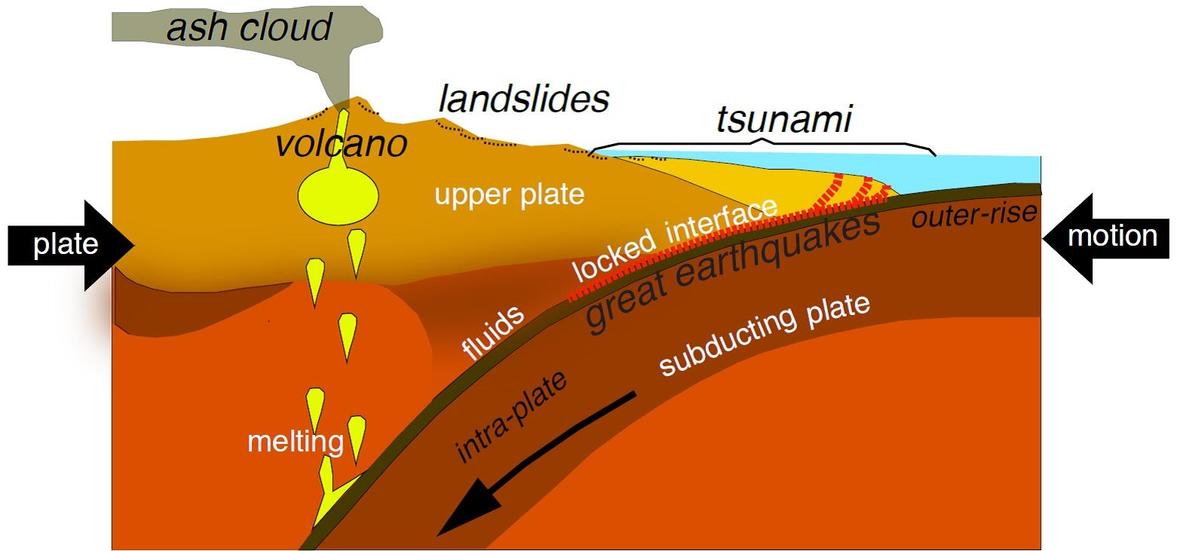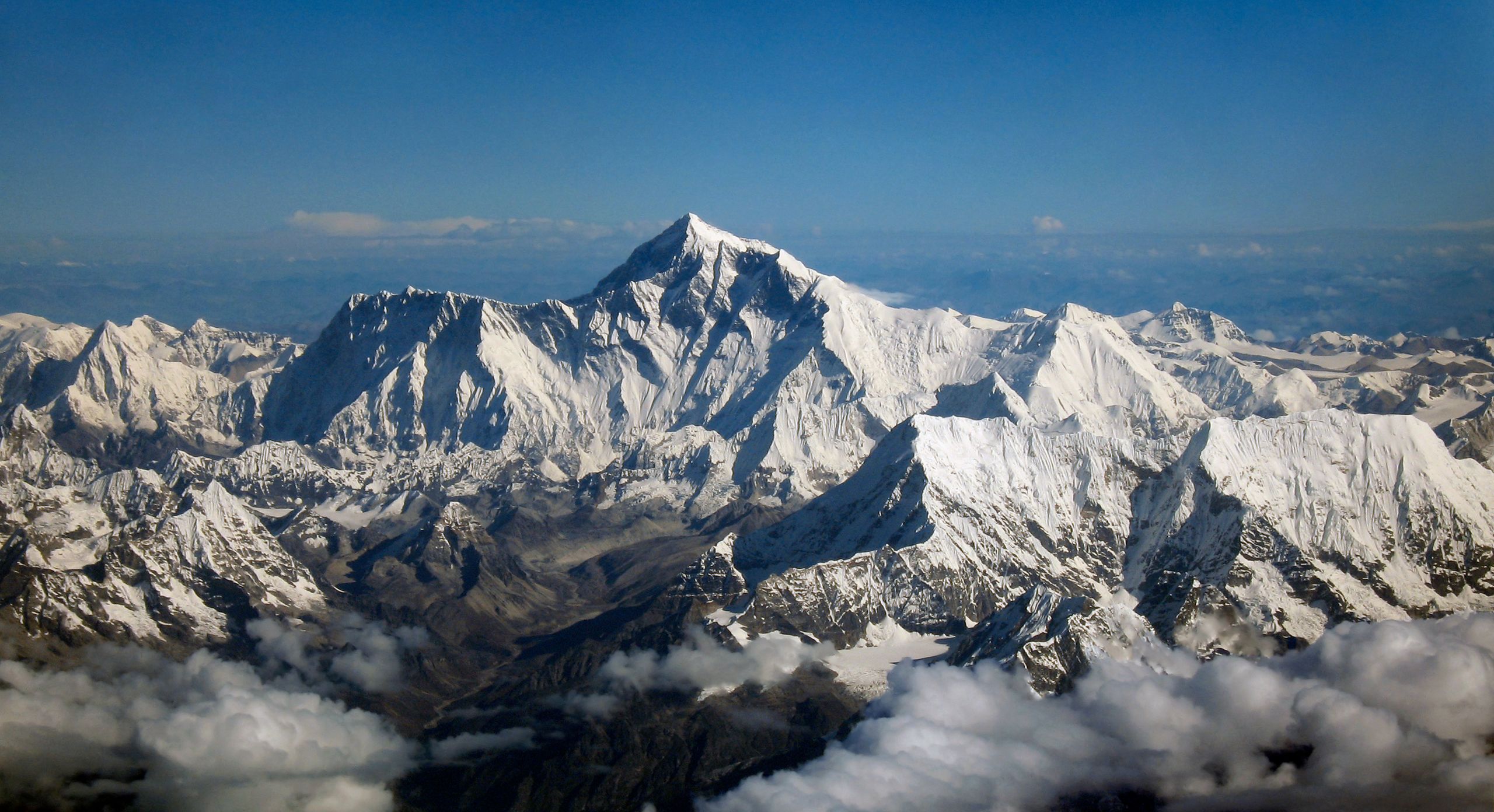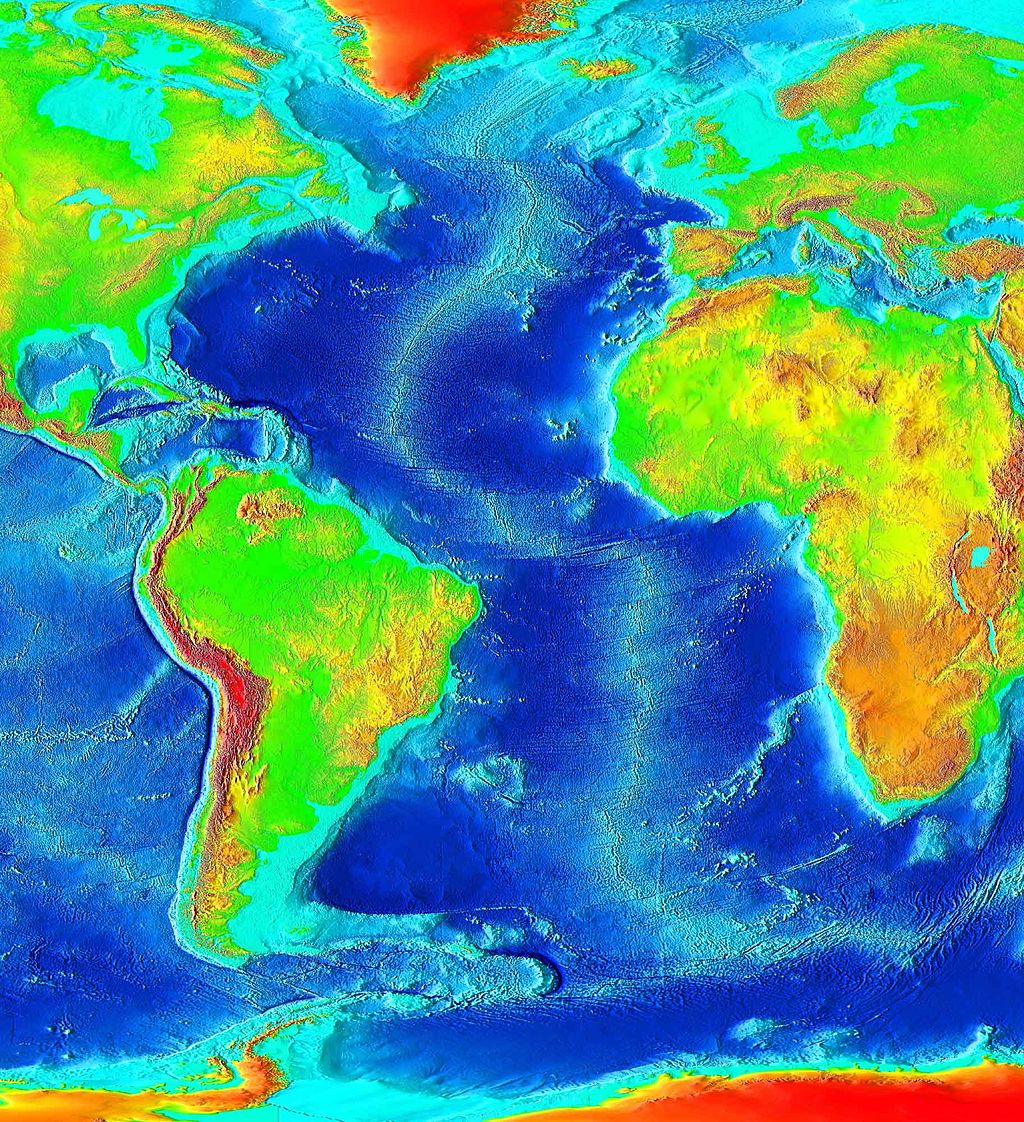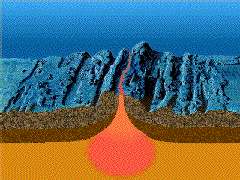2.8 Predicting Geologic Hazards at Tectonic Boundaries
Charlene Estrada
Plate tectonics explains why our oceans open and continents move throughout Earth’s history. This theory also explains why we have tall mountain ranges, valleys, and deep ocean trenches. However, what does all of this have to do with the geologic hazards and disasters that impact our society on a daily basis? In this section, we will explore how we can predict, and even come to expect, certain types of disasters near plate boundaries.
The Ring of Fire

If you have ever had a unit on earthquakes and volcanoes in school or watched a documentary on the subject, chances are good that you may have heard of a region called the “Ring of Fire”. Not to be confused with the Johnny Cash song, the Ring of Fire is enormous! It extends for around 40,000 km around the coasts that border the Pacific Ocean – from New Zealand to the Philippines, Japan, Alaska, the Western Coast of the United States, Mexico, and all the Western Coast of South America. The Ring of Fire is infamous for having heightened volcanic and earthquake activity, and that is a direct consequence of tectonic activity.
Convergent plate boundaries involving subduction primarily occur throughout the Ring of Fire. The release of volatiles such as water from the subducting slab enables the overriding lithosphere to melt easier, and volcanic arcs form.

Volcanoes are not the only consequence of subduction zones. When cold, rigid lithosphere is forced down into the asthenosphere, stress from that movement will build up in the rocks over long periods of time. There is a limit to the amount of stress a rigid object, such as a rock, can tolerate before it breaks. Once the rock does rupture under the stress, it releases the energy it built up over those many years in the form of a seismic wave – an earthquake occurs.
Because this energy is released from a plate that underwent tremendous stress deep beneath the Earth’s surface, the earthquakes at subduction zones can be as devastating as 9.0 in magnitude. Some of these earthquakes originate under seawater, which can result in giant tsunamis, such as the 2004 Indian Ocean Earthquake and the 2011 Tōhoku Earthquake in Japan.
KEY TAKEAWAY: SUBDUCTION ZONES
The process of subduction at convergent boundaries will produce volcanoes and moderate to severe earthquakes!
Gigantic Mountain Ranges

Subduction is not the only tectonic process responsible for the world’s geologic hazards! When two continental plates collide at a convergent boundary, the lithosphere is too buoyant to subduct, and large mountain chains build upward toward the sky. We know that Mount Everest is the Earth’s tallest mountain (above water, that is), and as part of the Himalayas, it has been built by a convergent plate boundary between the Indian and Eurasian plates.
Because there is no subduction at this type of boundary, however, the continental lithosphere does not melt easily. There is almost no volcanic activity around continental-continental convergent boundaries. Nevertheless, there are still the same compressional stresses acting between the plates, and those stresses will slowly build upon rigid rocks in the lithosphere until they break and release seismic waves. That means that like the other convergent boundaries, regions such as the Himalayas experience earthquakes. The lack of subduction may not allow these earthquakes to originate as deeply, but these earthquakes are often moderate, and sometimes severe, in magnitude.
KEY TAKEAWAY: CONTINENTAL-CONTINENTAL CONVERGENT PLATE BOUNDARIES
The process of mountain-building at continental-continental convergent plate boundaries will produce little to no volcanism, but moderate to severe earthquakes!

A far greater mountain range than the Himalayas can be found underwater, and it is produced by a different tectonic process. The Mid-Atlantic Ridge was the first example of a Mid-Ocean Ridge discovered by scientists, and is 16,000 km (10,000 miles) long. Divergent boundaries are sites of magma upwelling from the mantle because the tensional stress has thinned the lithosphere enough to allow the molten plume to penetrate the surface.

A divergent boundary, such as a rift or a spreading center at the Mid-Atlantic Ridge, hosts active volcanism on the axis of the ridge. Furthermore, new lithosphere is always being formed at a divergent boundary and pushing the old crust aside. This motion causes the older crust to fracture and rupture, which will produce earthquakes. The lithosphere at divergent boundaries is not very thick, and the earthquakes at these locations are shallow (< 30 km), but the magnitude can vary from low to moderate.
KEY TAKEAWAY: DIVERGENT PLATE BOUNDARIES
The process of continental rifting and mountain-building at Mid-Ocean Ridges will produce volcanism and mild to moderate earthquakes!
Shifting Ground
Transform boundaries will slide one segment of the lithosphere relative to another with results that are observable in our lifetime. However, most of that sliding motion is not something that happens on a day to day basis! As stress is applied at the plate boundary every day, these large units of rock will resist moving. Therefore, that stress will build over many years. Once the plates cannot tolerate any more stress, their rocks fracture, and the plate releases the energy by snapping past one another. Two things happen:
- The two tectonic plates move past one another in large amounts
- The energy previously stored by two plates is released as a shallow, but moderately powerful earthquake.
Keep in mind that there is no subduction at transform boundaries, and there are also no lithosphere creation/destruction processes. Because there is no opportunity for the lithosphere to melt from transform plate motion, there are few, if any, active volcanoes along a transform plate boundary.
KEY TAKEAWAY: TRANSFORM BOUNDARIES
The slipping motion at transform plate boundaries and their related faults will produce mild to moderate earthquakes but no volcanism.
The theory that the outer layer of the Earth (the lithosphere) is broken in several plates, and these plates move relative to one another, causing the major topographic features of Earth (e.g. mountains, oceans) and most earthquakes and volcanoes.
a narrow, deep depression in the seafloor that forms when a tectonic plate subducts at a convergent boundary. These features can extend as deep as 11 km deep.
A region extending along the islands and coastlines bordering the Pacific ocean that is affected by convergent and transform plate boundaries. These boundaries cause a higher incidence of earthquakes and volcanoes.
A region along Earth's lithosphere where at least two tectonic plates collide with one another.
The process in which the older, denser tectonic plate at a convergent boundary will buckle and sink into the lithosphere. This plate will always be composed of oceanic lithosphere.
The tectonic plate descending within a subduction zone into the asthenosphere, and beyond toward the deep mantle.
The outer, relatively rigid layer of the Earth that is composed of crust and upper mantle.
a chain of volcanoes that forms above a subducting plate at a convergent boundary. A volcanic arc may be associated with an island chain or a mountain ridge.
A ductile but solid, hot layer in the Earth composed of the lower crust and upper mantle that flows like putty over long periods of time. It drives the movement of the rigid tectonic plates riding above.
A type of force placed on an area of rock that presses or squeezes it tighter together.
The world's longest mountain chain found beneath the Atlantic ocean between North America, South America and Europe and Africa. The Mid-Atlantic Ridge is an example of a mid-ocean ridge, or MOR.
(sometimes abbreviated as "MORs" by scientists) an underwater mountain ridge in the middle of the ocean that is formed by seafloor spreading centers at divergent boundaries.
A region along Earth's lithosphere where at least two tectonic plates move apart from one another.
molten rock that can be found beneath the Earth's surface.
A hot interior layer of solid rock between the crust and core that is capable of plastic flow. The mantle is the largest layer of Earth.
A type of force placed on an area of rock that pulls or moves it apart.
A region on the ocean floor where magma from an active divergent boundary is creating new oceanic lithosphere, thus pushing or spreading the older lithosphere outwards.
A region along Earth's lithosphere where at least two tectonic plates slide past one another.

